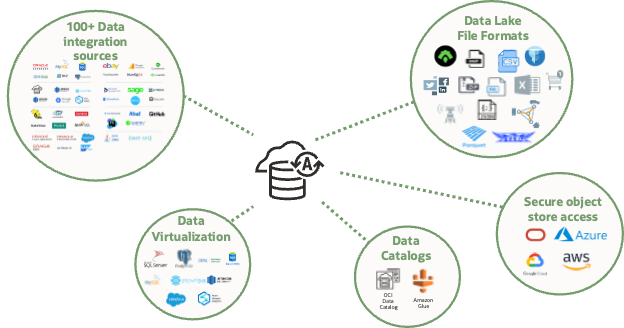As AI innovations flood the market, we continue to hear from our customers the challenges posed by needing to decipher all the jargon, learn new tools or even move their data to where the AI tools are. This is why we have embedded AI into our full-stack, including our databases, so you don’t need to take your data to gain AI capabilities.
With this goal in mind, we are introducing several enhancements to Oracle Autonomous Database including cutting-edge innovations for integrating AI and advanced machine learning into your applications. These intuitive and easy-to-use enhancements include:
- Autonomous Database Select AI now allows developers to create AI-enabled applications that understand users’ natural language questions in a conversational thread and get answers from private data.
- A new spatial enhancement in Oracle Machine Learning enables organizations to include location relationships in ML models for improved model accuracy.
- A new user-friendly “no-code” model monitoring interface simplifies the timely detection of quality and concept drift in ML models.
- A new UI for Autonomous Database Graph Studio enables the creation of property graph views on Resource Description Framework (RDF) knowledge graphs using a drag-and-drop method, allowing organizations to explore interconnections across knowledge silos without complex coding or data duplication.
Combined, these enhancements to Autonomous Database reflect Oracle’s ongoing commitment to provide you with the tools you need to integrate AI and ML into their applications, allowing you to quickly gain insights from data and make timely business decisions. These new innovations are all built directly into Autonomous Database, making it easy for any organization to immediately take advantage of them.
Converse with your data
Select AI is a groundbreaking feature released in September of last year that lets you analyze your data through Autonomous Database using natural language (see Autonomous Database speaks “human”). One of Select AI’s major benefits is that you can ask business questions without needing to understand where the data is stored or how to formulate the SQL query. It is accessible to any SQL application and is available as an integrated feature within Autonomous Database so you can take advantage of it immediately. Now, Select AI is even better with support for conversations.
Previously with Select AI, users could ask questions of their data via natural language (“What were my total sales this year?”) using Large Language Models (LLMs). However, there was no capability to remember previous questions and build on them as follow-up questions. Select AI now makes that chat history available to the LLM so that it can interpret the context of follow-up questions. Users can now have a “conversation” with their database to explore and narrow down the answers they need, just like a real-life discussion. In addition, to be completely transparent and validate your results, you can now ask Select AI to produce the generated SQL and a description of the query processing:
The bottom line is that the advantages of Select AI are its unique ability to enhance applications with AI intuitively and with minimal effort. Instead of requiring the use of custom coding and proprietary interfaces to try and integrate AI with applications, Oracle is focused on making enterprise generative AI adoption as intuitive as possible for developers and organizations overall.
Find out more about the conversation capability in Select AI, including use cases and examples.
“AI doesn’t exist without data. Of course, Oracle offers conversational access to the commonly available text data captured in large language models (LLMs) gleaned from the Internet, but that’s just table stakes. Everyone does that. What is hard, is extending this capability to structured data in databases, which have no definitions and no semantics, and where these things must be specified or inferred. This is where Oracle has a tremendous advantage as petabytes and petabytes of data are stored in Oracle databases. With Autonomous Database giving users an enterprise view of an organization’s data and Select AI providing a natural language interface with wide-ranging SQL translation and generation capabilities, you have a differentiated combination that pushes the boundaries of data interaction to new levels. To make it even more compelling, this capability is encapsulated within Oracle’s full-stack approach to AI which gives customers a universe of both structured and unstructured information at their fingertips.”
— Carl Olofson, Research Vice President, Data Management Software at IDC
Select AI tightly integrates with OCI Generative AI
We recently announced that Select AI will support OCI Generative AI. Today, we’re letting organizations know that support for OCI Generative AI is now available. You can accelerate application development or create new business solutions by securely combining your private enterprise data in Autonomous Database with the productivity and creativity of generative AI. Select AI with OCI Generative AI helps keep your data safe—data never leaves Oracle Cloud Infrastructure (OCI), is not shared with AI providers, and is secured using Oracle Database’s advanced capabilities. Check out the announcement or view these webcasts (overview | details for developers) to see how you can deliver compelling AI-driven solutions.
Enrich your analytics by leveraging context
Applying semantics to data and data relationships is very valuable; AI and machine learning algorithms can use those semantics to help generate more compelling and reliable results. There are two significant Autonomous Database enhancements that help you exploit that business context: analyzing relationships and connectivity defined by knowledge graphs and using geographic locations to build more effective machine learning models.
Easily analyze relationships defined by knowledge graphs
RDF Knowledge graphs help apply meaning to data relationships by capturing complex associations across data in institutional silos. Organizations can get additional insights from the data within the knowledge graphs, but it has not been easy to do so without duplicating data or complex coding. Now, you can easily uncover hidden relationships by applying Autonomous Database’s built-in graph analytics like path finding, centrality, and anomaly detection algorithms to knowledge graphs through a property graph view. Setting up the property graph model is easy with a new no-code user interface in Graph Studio.
Find out more about property graph views on RDF knowledge graphs, including use cases and examples.
Improve machine learning with location information
A geographic location can be an important input into a wide range of predictive analytics. A new enhancement to Oracle Machine Learning for Python (OML4Py) empowers developers and data scientists to create machine learning models that incorporate location relationships while leveraging Oracle Spatial’s native support for spatial data types, index, and analytics. Data scientists can detect spatial patterns through a quantitative approach—such as spatial clustering, regression, classification, and anomaly detection—without moving the data outside the database or writing complex algorithms on their own.
Find out more about spatial integration with machine learning, including use cases and examples.
Keep ML solutions effective and on-target with “no-code” model monitoring
Real-world machine-learning deployments face real-world challenges: fraudsters adjust behaviors, customers’ purchasing patterns evolve, and microeconomic or macroeconomic changes may sway entire marketplaces. MLOps staff must constantly be on the lookout for ‘model drift’—when their ML model’s accuracy starts to degrade due to a variety of external factors. The new model monitoring UI helps expert and non-expert MLOps staff monitor the effectiveness of ML models with just a few clicks and no complex coding, enabling them to quickly make adjustments to the ML models when needed.
Find out more about monitoring your models.
It all goes back to your data
AI and Ml clearly can’t exist without data. The results from AI and machine learning will only be as effective as the data they operate on. Autonomous Database dramatically simplifies your analytics applications by providing an integrated view of your data estate. It offers built-in capabilities to access and prepare data for analyses from 100s of applications, data lakes, and databases. Autonomous Database allows you to take advantage of your data lake catalogs—such as Oracle OCI Data Catalog and Amazon Glue—and make that data immediately accessible for analytics with zero management required.

Summary
Advances in AI and machine learning are moving at breathtaking speeds. Using Autonomous Database helps your organization overcome many of the challenges with adoption: data complexity, data privacy, organizational skill sets, and operationalizing analytics. There is not a better time to innovate with AI and ML.
For more information:
- Visit Autonomous Database product page for demos and get-stated resources
- Visit OCI Generative AI page
- Read technical blogs for more information:
- Try Autonomous Database for free
